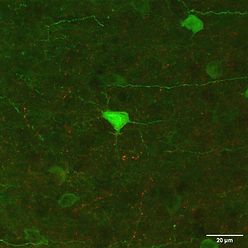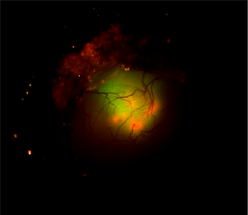
Explore the Frontiers of Neurosciences Research
Asynchronous Plasticity of Feedforward and Feedback Circuits (Morgane)
In this project, we aim to uncover how learning reshapes cortical circuits while preserving normal brain function. Our central hypothesis is that the direction of information flow—feedforward, from the eye to the cortex, and feedback, from higher to lower cortical areas—is reorganized during specific sleep phases. We have already discovered that learning strengthens key properties of the feedback pathway. We are now investigating precisely which sleep phases drive these changes.

Neuromodulatory Control of Cortical Circuits (Leafy)
We use optogenetics to investigate the modulatory effects of serotonin on cortical processing within the visual cortex. This approach allows us to elucidate the roles of distinct neural circuits in sensory integration, with the goal of uncovering fundamental mechanisms underlying perception and brain function.

Asymmetric impact of amblyopia on feedforward and feedback pathways in visual cortex (Valentin)
Amblyopia is a developmental visual disorder affecting about 3% of the population, impairing vision and proper visual cortex development. While the causes for amblyopia are well understood, the known physiological deficits in visual cortex are insufficiently strong to account for the behavioral consequences of amblyopia.
This project aims to investigate how amblyopia alters both feedforward and feedback pathways using two-photon and widefield imaging in mice, as well as fMRI in humans, to provide insights that may guide new therapeutic approaches.

The Circuit Architecture of Sleep-Induced Memory Consolidation (Lea)
Memory consolidation is a crucial component in an animal’s ability to learn new skills, and is known to be strongly modulated by sleep. However, the specific cortical modulations that take place in sleep-induced memory consolidation remain largely vague.
The aim is to unravel the basic components that enable memory-consolidation during sleep, from the single cell level all the way up to the behavioral output, using a multilevel approach as mice training in a go-no-go paradigm, optogenetic cell activation, and patch-clamp recordings.

Effect of Dark-Rearing on Feedforward- and Feedback-driven visual responses (Madan)
Neuronal responses in primary visual cortex are influenced both by feedforward information from the retina as well as by feedback responses from the higher visual cortical areas, with the feedback information representing surround and predictive information.
The aim is to characterize the effects of a lack of visual experience via dark-rearing on the response properties of V1 neurons, and how these responses change after visual experience acquisition.
Sleep-Dependent Plasticity of Local Cortical Circuits (Alex)
The sensory cortex is composed of millions of neurons intricately connected in highly specific ways. During learning, these connections undergo extensive re-structuring, but the mechanisms guiding this process remain poorly understood.
This project will explore how sleep contributes to the re-structuring of local connections in the sensory cortex, using a combination of imaging, electrophysiology, and optogenetic techniques.
